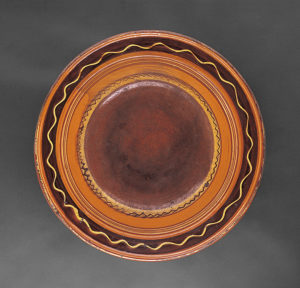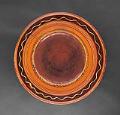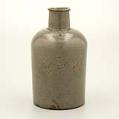Collection: Mariner Southern Ceramics Gallery: Tradition

Bowl
Peter Bell
Winchester, Virginia
1824-1830
Lead-glazed earthenware
DIA: 22 3/4″; HOA: 4 7/8″
Gift of Mr. Titus Geesey (2352.1)
Throughout time, the secrets of pottery making have been closely held within families and passed to successive generations. In America, family dynasties such as the Bells, the Duches, and the Landrums, and the Remmeys are among the recognizable names that have shaped the history of Southern pottery.
The earliest surviving example is a jar attributed to Andrew Duche, son of the highly successful Philadelphia potter Andrew Duche. The jar, prominently marked “AD,” is reminiscent of the family’s Philadelphia style of making earthenware. Having left Philadelphia, Andrew established pottery works in Charleston, South Carolina, and Savannah, Georgia, in the 1730s. Most importantly, he is recognized for his crucial role in the discovery of American kaolin—the fabled “Cherokee Clay” of western North Carolina—and his experimentations that led to the development of both American and English porcelain.
Another individual who shaped the nature of Southern pottery was Dr. Abner Landrum. A renaissance man of science and history, he developed an alkaline-glazed stoneware that mimicked the Chinese style of glazing and firing. His brothers John and Amos established their own potteries in Edgefield, South Carolina, and trained others in the tradition. Some of these, Cyrus Cogburn, Abram Massey, and James Kirbee, brought the tradition with them as they migrated west to Georgia, Alabama, and Texas. The small bottle exhibited here is signed in script “A. Landrum” and dated “July 20th 1820.” Made at his Pottersville Stone Manufactory, Landrum’s bottle is the most historically significant piece of Edgefield’s alkaline-glazed stoneware known.
The Shenandoah Valley was a cultural melting pot, blending a variety of influences from the Scots-Irish, English, German, and Swiss immigrants who settled there. Of the potting clans that settled in the region and were part of this rich heritage, none was more important or long lasting than the Bell family. The progenitor of this potting dynasty was Peter Bell, who worked first in Hagerstown, Maryland, and later Winchester, Virginia. This monumental slip-decorated bowl, stamped “P. BELL” three times on the bottom, is a rare marked example of his work. Although few examples of Peter’s work have survived, pottery from the shops of his sons—John, Samuel, and Solomon —are among the best-known and most widely collected Southern ceramics.
Surprisingly very little Southern pottery is marked by the maker. This small salt-glazed stoneware squat pot is an exception that proudly proclaims the name of Emanuel Suter, a highly prolific Rockingham County, Virginia potter related to other Mennonite potters in the Shenandoah Valley. His name was applied within a decorative cartouche by using cobalt slip applied over this surviving brass stencil, which suggests that Suter made special effort to differentiate his products from others.
The role of women in American pottery production is largely invisible. Certainly women worked in family potteries, but little of their presence is documented. One exception is Mary Adam of Hagerstown, who in 1819 took over the pottery business of her late husband, Henry, in order to make a living on her own. The large earthenware jar displayed here has her incised signature “Mary Adam” in bold script on the bottom. This is the earliest known Southern example signed by a female potter.






